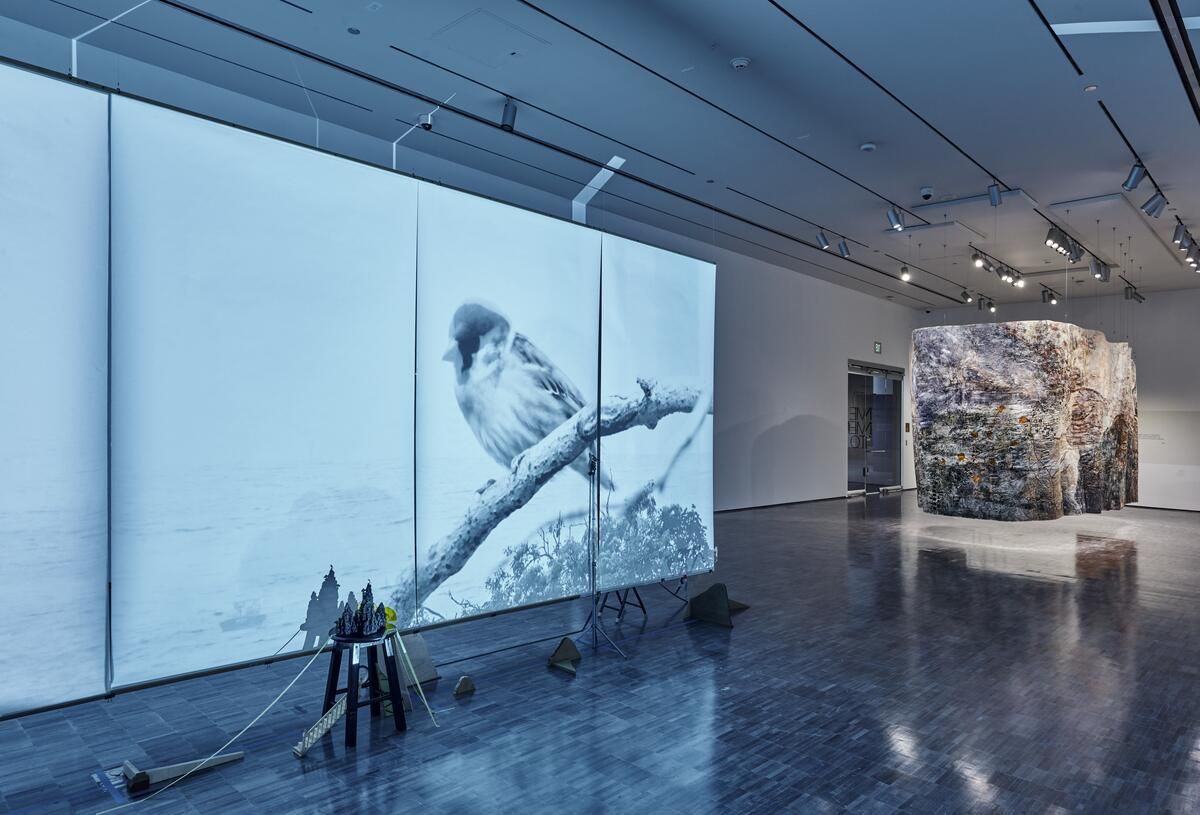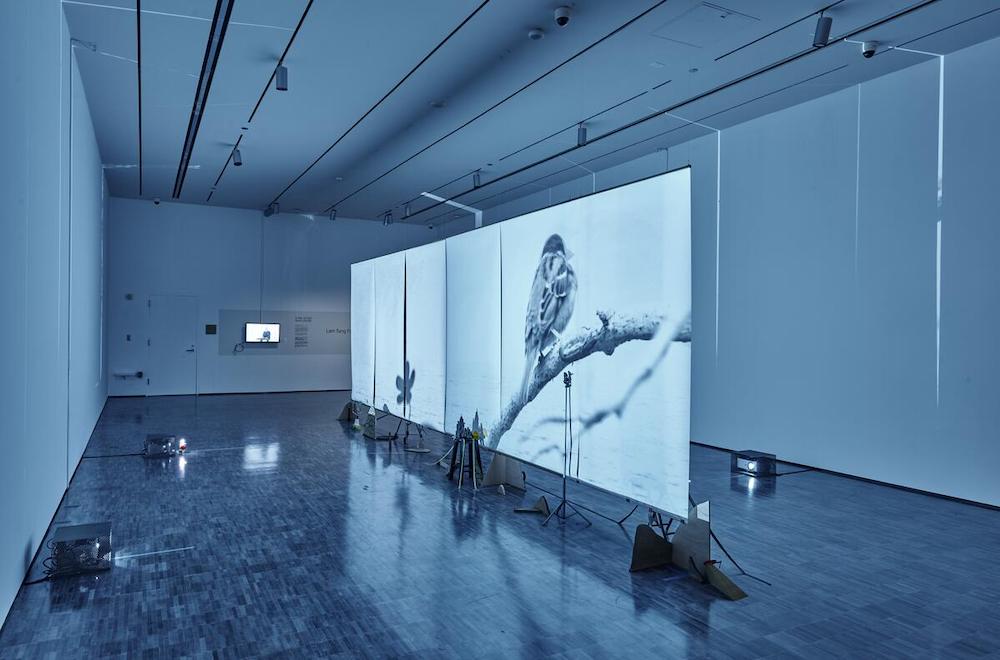San Francisco’s Asian Art Museum, known for its ancient artworks, such as a large jade collection, Korean moon jars, Chinese bronzes, and statues of buddhas, bodhisattvas, and Hindu deities, has been building an impressive collection of contemporary art since the arrival of Abby Chen in January of 2019 as the new contemporary art curator.
Three works by living women artists are visible from outside the building; Chanel Miller’s I was, I am, I will be, showing healing as a process; Jas Charanjiva’s Don’t Mess With Me, a bright-pink work with a woman in traditional Indian bridal dress and brass knuckles reading “Boom,” made in response to the fatal 2012 gang-rape of a woman in Delhi; and Jenifer K. Wofford’s bright Pattern Recognition on an outside wall.
Inside the museum, After Hope: Videos of Resistance, a loop of about six-and-a-half hours plays 24 hours a day, with short videos from regions such as Azerbejian, Mongolia, Kazakhstan, and Turkey. There’s also Marin artist Zheng Chongbin’s, I Look for the Sky, about how light changes our perception of architectural space.
And now, the museum has a dedicated gallery for contemporary art. The inaugural show, Memento, has two large-scale immersive works, both dealing with urbanization and changing cities. The museum is the first in North America to collect the two artists, Jayashree Chakravarty and Lam Tung Pang.
Chakravarty’s Personal Space, (2001), is a huge scroll with an imaginary map made of strips of paper and Pang’s A day of two Suns (2019) features a video installation with four projectors showing the landscape of Hong Kong changing and reappearing, and visitors’ shadows on the screens becoming part of the work.
Chen talked with 48hills about the connections between ancient and contemporary art, why she chose these two works for the inaugural exhibit, how what happens in Asia affects what happens here, and how creating understanding counters misconceptions.

48HILLS Why is important for the museum to have a gallery for contemporary art?
ABBY CHEN Let’s talk about that, because now that it’s there, we sort of take it for granted. But it’s a newly dedicated gallery for the contemporary art collection, and I think that demonstrates the collective determination and the commitment to contemporary art from the Asian Art Museum’s leadership team as well as the board. I think it’s important to recognize that was a huge step made very deliberately by the museum director, Jay Xu, and the board.
48H What does having a contemporary gallery say to visitors about the museum?
AC I think it’s showing the museum’s effort to connect. When I say that I would like to think it’s the connection between the public and the museum, as well as the connection from the ancient to the present. It’s also the audience who knows the museum and its dedication to archeology and history and how that connects to the current moment. That’s why the Memento debut, this inaugural exhibition at the Hambrecht Contemporary Gallery is significant. Both these works demonstrate how that connection with the past indicates the future. Part of the museum’s role is in highlighting these voices from there to here, both in a sense of geography and of time.

48H Talk a little bit about the two works in the gallery—why did you want those for first show?
AC It took a lot of time to think about this show and what kind of art we should put in there for this inaugural show, especially for contemporary art with a specific relevance to the Asian Art Museum. I think these two works carry their own significance.
The first one is by Jayashree Chakravarty, a Kolkata-based artist, and the other is by Lam Tung Pang, a Hong Kong based artist. Both are large scale for that room, and there’s this bodily encounter with the pieces, which I think is very important for a museum like ours. The collection has been heavily focused on archeological items and antiquity, right? And there is this very protected environment with these glass cases and this kind of protective barrier to the work. But with these works, there’s this physical presence and direct access that I think adds another dimension to how audiences experience the work.
Jayashree Chakravarty’s work is paper-based, and it shows this kind of visualized psyche of how the artist is internalizing the change of her environment, as Kolkata becomes rapidly urbanized. Then there’s this video in the gallery with her talking about her process, which gives a lively, behind the scene feel of how the work was made.
Then with Lau’s work it was the artist invitation into this painting-like video installation, a three-dimensional space that he is inviting the audience to take part in. With contemporary art in the museum, I want to be very mindful of the museum’s existing collection. The focus of contemporary art is not to emphasize “contemporary art” as a different genre, but really to reestablish this connection of the contemporary art with these ancient artifacts. There’s this nonlinear correlation that hopefully these two works will help our audience have a better understanding of our collection on the second and third floor.
48H Can you give an example?
AC With Lam Tung Pang’s work, the painting has a lot of aesthetics that draw from Chinese landscapes and he applies his contemporary understanding for this artwork. So even though the aesthetics draws from ancient Chinese painting, he will use different treatments such as the miniature module into the landscape, and there’s this idea of what is stabilizing and what is temporary and what is appealing and what is disappearing. So it’s like this painting in motion. He’s also applying the aesthetic of a Japanese screen, so he’s combining different artistic references in the work.
For our audience familiar with the classical artwork, this provides another view of how to appreciate the ancient work more. But the understanding of the ancient work will make the contemporary work more accessible, so there’s this kind of interloping, intertwining relationship that will help connect both worlds and show that they’re part of one world.
Jayashree Chakravarty’s work is about how urbanization is affecting her mind and we see multiple layers of emotions applied to the work about a city in turmoil. Lam Tung Pang’s work also documents loss and rebirth, with disappearance and reappearance through his work. I don’t think the ancient works created by artists were any different. Their tools are different, and their means might be different, but they are connected. This was one of the starting points when I was thinking about what kind of work to put into this gallery.
When you think about American life and Asian American life in this country, we are constantly living in the here and there, and what happens in Asia always influences what happens here. Whether it was the time Japanese militants attacked Pearl Harbor and then the Japanese Americans in this country got sent to internment camps, or after 9/11, people who looked remotely Muslim were under attack. And right now, with COVID -19, anybody who looks like they’re East Asian can be under attack. So our life is always connected to what’s happening in Asia and fostering this understanding of humanity is a role I think a museum can play.
There’s something both very classical and very innovative about Chakravarty and Pang’s work. We want to celebrate them at a critical point in their artistic growth. With what’s happening in this country, it’s important for us to provide a layer of understanding when there’s a kind of scapegoating of Asian Americans in this country and there’s—I’m filled with so many emotions I don’t even know what’s the right word to say—this kind of misconception about Asia and demonizing of Asia, and it’s important to focus on what is being produced out of Asia right now to introduce these artists to the audience in America and the Asian Art Museum can be a connector.





